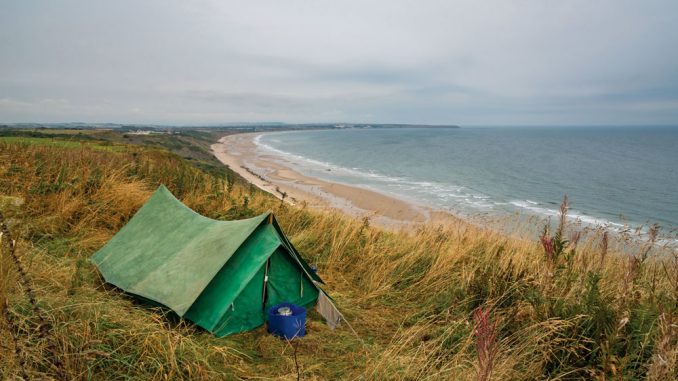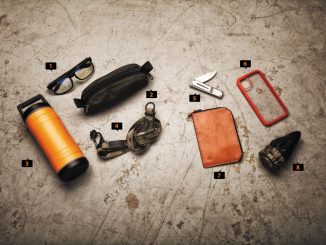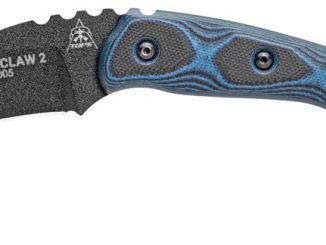
I grew up with parents who saved everything useful, or potentially useful, just in case. No, they weren’t hoarders. They grew up during the 1930s, during the Great Depression—a time when you never knew when you’d need something that you couldn’t afford to buy. While I’m not as bad as my parents were, I still try to use and re-use gear until there’s nothing left to use. Eventually, I have to come to grips with the fact that there’s a time to say, “When.” This article is about deciding when that time is.

This pack is old and has seen better days. Make sure to check all seams—and especially the straps—for damage from cracks and dry rot.
Just because your gear might have worn out, it doesn’t mean you have to go out and replace it with something new. In our day and age, people replace their gear and equipment—whether they need to or not—with the newest stuff that hits the market. The only reason they do so is because persuasive marketing campaigns have told them that they need to. How many people do you know who buy a new car every few years or have to have the latest cell phone, computer or gadget? The same applies to survival gear.

It’s very important to inspect your boots often and repair them if possible—or replace them before the situation becomes a threat to your health and safety.

This pair of Rocky boots replaced the author’s old hunting boots. They’re lighter and better insulated, so this is a trade up.
The next thing you know, those people are trying to get rid of their “old” gear. Often, they end up selling it for low prices at a yard sale. This could be a win for you, the potential buyer, if you know what to look for. I’ll touch on this aspect as well.
Determining What Stays and What Goes
Most of us who are self-reliant and who’ve been prepping for a long time have a tendency to become attached to our gear, so determining when it’s time to let go can be difficult. With that said, all things wear out or just don’t fit the need anymore. You have to be practical, as opposed to sentimental. When determining what stays and what goes, you need to look at a few key points.

While this tent can provide decent accommodations for one or two, as your family expands, you’ll need to move up in size and performance from this style. Consider trading up or saving it for when the kids are old enough to be in their own tent.

These boots have seen better days. Check them very closely and replace them if needed
First, is it worn out? Second, does it still fit the need, or is there something significantly better? In a prepper/survival situation, efficiency is everything. Every tool must have multiple uses, and weight and space must always be considered. That old Army surplus rucksack, for instance, while great in its time, might not fit the bill anymore.
Is It Worn Out?
Whether it’s clothing, a pack or a pair of boots, you need to take a serious look at it. Faulty or worn-out gear can lead to catastrophic occurrences that could cost you your life. You wouldn’t rappel with a frayed rope, so why would you trust your survival items to a faulty pack? With clothing, check all the seams and zippers. Loose seams can let in cold air, debris or bugs, and a faulty zipper is even worse. Have you worn holes in your pockets? This is very common if you happen to carry small tools and keys in them. Holes in your pockets could prove to be an issue: You are likely to find all your EDC gear falling out as you walk. Are the knees on your pants wearing a little thin? Repairs are fairly easy to make, but how many times are you going to repair them before you decide to move on?

There’s a big difference here. The Rocky boots (right) are higher, insulated, waterproof and better-suited for hunting. The shorter boots are better for general use on the trail and around camp.
Be honest with yourself. Eventually, enough is enough, as they say. One of the most important pieces of gear you have is your boots. Without your feet, you’re out of the game. Even the best boots wear out. The place where boots tend to wear out first is where the uppers meet the soles. This is where the glue and stitching are; and, just like the knot on a fishing line, this is the weakest point on your boots. If this seam begins to let go, your feet will soon get wet. It could also create a tripping hazard. Eventually, it will part company in earnest—usually in the worst situation. If this happens, you’ll be in a world of hurt.

This old axe is a little worn, but it’s still a great tool—and it’s a good example of another thing that’s worth saving.

With a little work, this old axe can be brought back to life as a tool that functions as good as new. (They don’t make them like this old-timer anymore!)
For this reason, it’s very important to inspect your boots often and repair them if possible—or replace them before the situation becomes a threat to your health and safety. Some brands offer reconditioning services that can extend the life of your purchase. Look into this before buying a new pair of boots.
Packs, Tents and Other Gear
The pack you carry all your stuff in and the tent you seek shelter in are both very important. This is your stay-alive equipment. The last thing you want to have while on a trek is a failure of some sort, but it does happen. Emergency repairs can usually be accomplished with a needle and thread, but this might be a short-term fix. Sooner or later, you’ll need to replace the item. Your best move, by far, is to find the potential problem before it becomes an issue. Inspect your pack—as well as any other piece of gear that has seams (such as tents and clothing)—often.

This old drawknife was a great find. It’s a valuable tool, and all it needs is some TLC.
When it comes to packs, it’s the shoulder straps that give way the most. Let’s face it: We all tend to overload our packs. That overloading puts excess stress on these sewn points. We also have a tendency to grab our packs by the straps and sling them around. This sudden jerking also puts stress on these areas. Most tents are also made with seams. Constant use and stretching during setup, as well as extreme weather, can stress these seams. Thankfully, many of the newer tents combine a sealant or tape with the traditional sewing, which strengthens the seam. Even so, nothing lasts forever. Visually inspecting every seam on your tent before each outing (or at least once a year) will help prevent issues from happening at the worst possible time.

This old, French machete dates back to at least the Vietnam War era; perhaps it’s even older. Nevertheless, it’s still going strong … because it’s been taken care of.
Zippers are also a potential weak spot in many products. Be sure they’re not blocked when you’re opening and closing them so they don’t jam, which can result in failure. Don’t let them get kinks/twists or overstressed, and chances are that they’ll last as long as the rest of the product. Replacing a zipper can be difficult and expensive if done by a repair service, so proper care and use is the way to go.
What to Look for in “New” Gear
So, you’ve decided to replace your old gear. Does that mean you’ll head immediately to the outdoors store or shop online for the latest and greatest? I say, only after you’ve checked your other options. There’s a good chance you can pick up some good-quality used gear at a fraction of the cost of new. Check with friends or for yard sales and online sales sites to see what’s out there. You might be surprised by what you might find.

Here’s a good shot of a seam letting go. It could be repaired, and the zipper could be replaced, but the insulation is compressed and has lost its efficiency.
However, never buy used gear sight unseen—unless you trust the person selling the gear—because you might not get anything better than what you already have. If you must buy new, purchase gear from reputable sources, and try to time your buy with a sale or promotion. Don’t go for the “bright and shiny” just because it looks good. Instead, make your purchase based on function. The prettiest item, no matter what it is, is no good if it doesn’t do the job you want it to. Before any purchase, inspect the known weak points—such as seams, as we already discussed. When it comes to clothing, look for reinforced knees; check the zippers; and look for double-stitched pockets. Make sure it’s made for “go” and not for “show.” (For instance, when I purchase new clothing, I like the products put out by 5.11 Tactical. I own a few sets of its Stryke series of shirts and pants, and I’m pleased with their performance.)

The zipper on this coat is clearly gone. The author’s wife bought this coat for him many years ago. Since then, its zipper has been repaired many times. It’s time to let this coat go and get a new one.
My boots are something I never purchase secondhand. As with my clothing, I purchase my boots from trusted dealers. Yes, you can find good boots in large retail stores, but when it comes to my feet, I don’t like just rolling the dice and hoping for the best. I’d rather spend the money and get something that’s going to last. (I currently own boots from Rocky, 5.11 Tactical and Blackhawk. So far, I’m very happy with the choices I’ve made.)
Purchasing Used Gear
Packs are items you can pick up used and get some really good deals, if you know what to look for. I’ve seen some good, used military items at surplus stores, and I’ve also seen some really bad stuff that should’ve been thrown out. I’ve seen great Blackhawk and 5.11 Tactical packs for sale at yard sales. These are usually items someone purchased, used once or twice and realized they weren’t right for them. But their mistake could be your lucky find.

These old axes are valuable tools. As long as their heads can be sharpened and their handles can be replaced, the author would never part with them.
If you do purchase a used pack—no matter the manufacturer—check it out thoroughly before taking the plunge. Don’t get caught up in the hype and buy it simply because of the name. This is a common mistake that often ends with buyer’s remorse. If it feels right, and you decide it’s worth the risk, buy it—but buy it only for the price you’re willing to pay. Sometimes, it’s a matter of “no risk, no gain.” Before you spend your hard-earned money, inspect the pack’s shoulder straps, buckles and closures for obvious signs of abuse. If the straps are no good, it really doesn’t matter about the rest of the pack. At the end of the day, it all boils down to what works the best for you. We all get attached to our gear, but there comes a time when we have to say, “When.”

Although you’ll have to search through a ton of stuff, thrift stores could yield some good finds, so don’t overlook them.

A pair of the author’s old boots. Their treads are pretty worn down, and there are other issues. But proper care has gotten them to last this long.

The treads on these boots are worn. However, they can be re-soled, because their soles were attached to the uppers with heavy-duty stitching. These boots served the author well for 30 years, but they’re worn out on the inside. Time to let them go.
And when that time comes, knowing what you need and what to look for are very important considerations. All too often, we get caught up in the moment and purchase something that really won’t do the job or is way too expensive, usually because some ad caught our attention. That’s marketing at its best. Search for the best values for the quality gear you need. Sometimes, that means buying used, and sometimes, new gear is the only way to go. There are some great bargains out there if you know what you want and what to look for.
Editor’s Note: A version of this article first appeared in the July, 2020 print issue of American Survival Guide.





Be the first to comment